Brewing with kveik
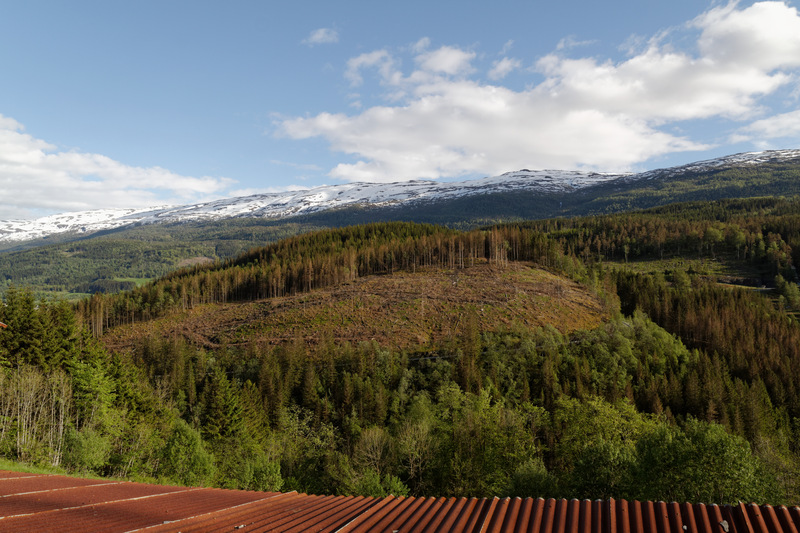
The view from the farm |
We didn't really know what we were in for. We'd been invited to brew with a home brewer in Vestbygda outside Voss, who claimed to brew the traditional way, and to use kveik. That is, his own private yeast strain inherited in the family since, well, since nobody knows when. That was all we knew. So it was with some uncertainty we stopped at the railway station outside Voss and called our hosts. (This is part 1 of the Norwegian farmhouse ale trip.)
Soon, a young man in a battered pickup truck showed up, presenting himself as Yngve. He was the son of the brewer, Sigmund Gjernes. We were led a couple of kilometers along a narrow, winding road through pine forests, going steeply up the hillside. We were brewing on a farm, though it didn't much look like one, since the fields were all out of sight, hidden by folds in the steep hillside.
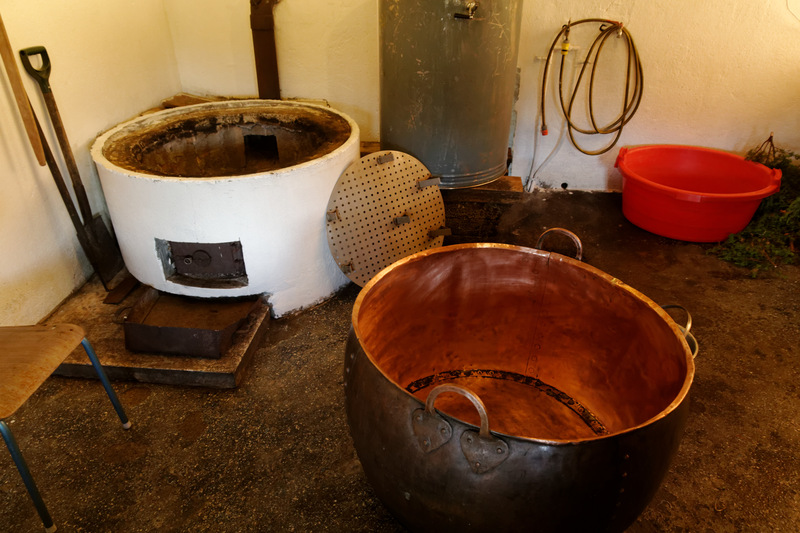
In the brewery |
Our contact, Eirik, and Sigmund the brewer met us, and took us to see the brewery, which was a room in the basement. A section of big concrete pipe had been cut and turned into a fireplace, onto the top of which a huge copper kettle fit exactly. The kettle is a lovely piece of work, dating from the 18th century, with room for 340 liters. A big metal mash tun, doubling as fermenter, a plastic tub, and a big home-welded steel serving tank made up the rest of the brewery. For me it was instant deja vu, being so similar to the brewhouse in Kaupanger where I helped brew my first traditional beer.
We'd been told beforehand that they had no more of last year's home brew left, but Sigmund checked the tank again, and poured a glass of muddy pale beige liquid, looking more like cappucino than beer. This was just the dregs, not really meant to be drunk, but Martin and I threw ourselves over it to see what we were going to make. We couldn't really judge it very well from this sample, but one thing stood out: a strong aroma of orange-peel and Christmas spice. We were completely baffled. Where did this aroma come from? The ingredients were supposed to be juniper infusion, pilsner malts, kveik (the family yeast), and noble hops. The source had to be the kveik, but who ever heard of a yeast that makes orange-peel aroma? This had to be investigated.
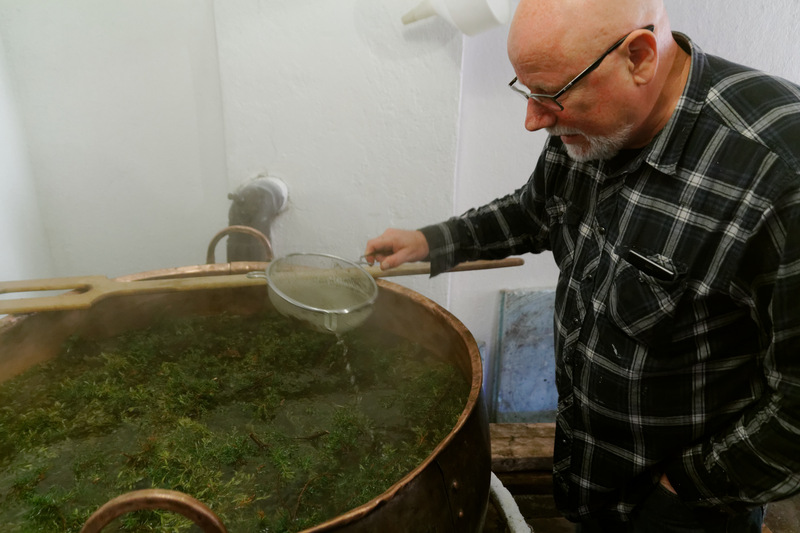
Sigmund fishing out dirt |
The big copper kettle was filled with water and juniper branches, and a fire started underneath. Unlike Carlo, Sigmund used only the only the tips of the juniper, and no branches. On the subject of berries they were in full agreement: the fewer the better. Having started the fire, a quiet period followed. Heating 300 liters of water to 80C takes a while, even if you're heating it over quite a big fire. As we waited, Sigmund would now and then take out a kitchen sieve and remove things from the infusion. Asked why, he grinned and said, "all sorts of things come with the juniper. Like spiders. You don't want that in the beer."
Eventually, the infusion was hot enough, and we could mash. Sigmund did this by putting a portion of ground malts in a plastic tub, pouring hot juniper infusion on it, and stirring for a good ten minutes. To make it easier to stir Sigmund would add an extra measure of infusion. The tub was quite small, so we had to fill it four times in order mash all the malts, taking it in turns to stir the mash.

Martin mashing |
The malts were tipped into the mash tun, which had a metal grating at the bottom, with a filter of juniper branches on top. Once all the malts were in, Yngve poured in hot juniper infusion to get the right temperature. Then the mash tun was wrapped with a styrofoam cover in order to stay warm, and left alone. To our surprise, the mashing was going to last a full six hours! By now it was midnight, so we were going to sleep while the malt mashed.
Three to four hours is the norm in Voss, but in order to get more sleep Sigmund extends it to six. This is why the insulation is necessary, to keep the temperature up so that lactic bacteria don't turn the beer sour. In the morning the temperature would be down to around 50C, Sigmund said, which is just enough to prevent the mash from turning sour.
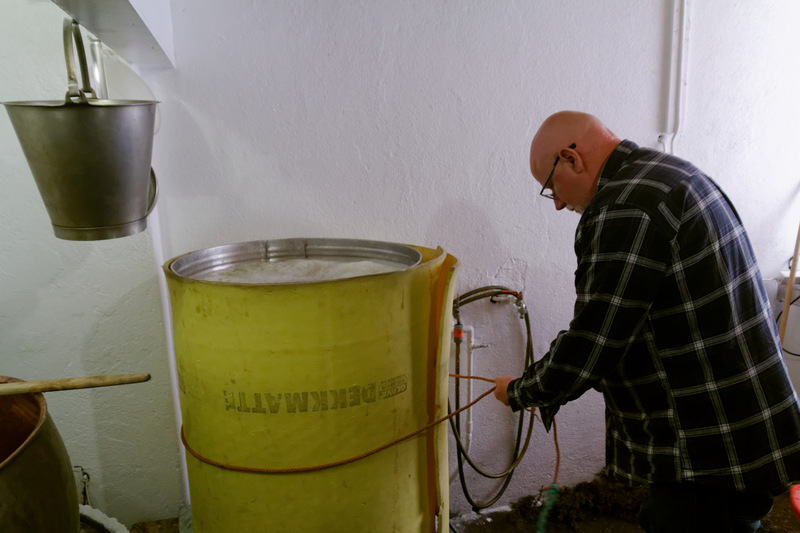
Sigmund insulating the mash tun |
We were led to a small apartment on the third floor, where we quickly crashed into our beds and passed out. Seemingly moments later I heard Yngve coming up the stairs, to tell us brewing was starting again. Getting up was not very easy, but somehow we did it. Later Sigmund told me that one guy who wanted to learn how to brew had struggled with this. He just couldn't get up in the morning, and so missed the first session. Six times he'd been over to brew, and every single time he'd failed to get up. The seventh time he'd solved the problem by not going to bed, which worked great until he fell asleep in a corner at 10 o'clock in the morning.
The first step was to start the running, tapping the wort from the mash tun into a steel bucket. As in Kaupanger, it was important to keep a thin, but continuous flow. Once the bucket was full, it was poured into the kettle, and the fire started underneath the kettle again. You can't start the fire without liquid in the kettle, as that will turn the copper black and brittle, destroying the kettle. The running and boiling is a slow process, taking hours to get the 300 liters of wort out of the tun.

First wort ready to boil |
We poured some wort into a glass. It was deep golden, and very sweet. The flavour was much as you would expect, sugary, syrupy and malty, with a dose of juniper in the background, and even some rough bitterness from the juniper. No hint of that orange-peel flavour. So far, so good.
Sigmund then brought out the kveik. The first thing he showed us was a traditional yeast ring. This looks like an intricate wooden necklace, which is used to gather yeast from the top of the fermenter, which then dries on the wood. You then hang it up somewhere until it's time to brew again. Yeast dried like this can supposedly stay good for years. Sometimes people get mold on it, in which case they throw it away and get kveik from somewhere else.
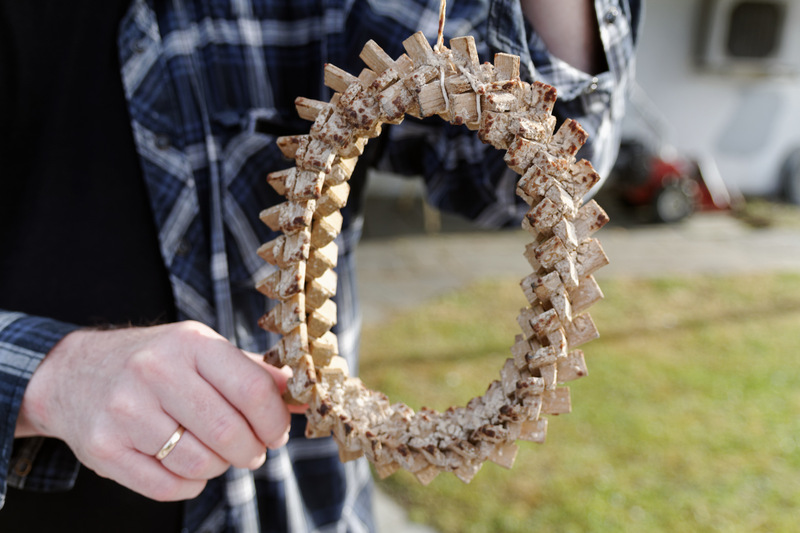
Yeast ring |
Outside, he had a big glass jar, screwed tightly shut with a rubber band, which he'd kept in the refrigerator since the last time he brewed, six months ago. Inside was a thick, muddy substance: the kveik. On top a deep brown liquid had separated out. Sigmund opened the jar and asked us to smell it. And there it was again! A deep, earthy, yeasty orange-peel and spice aroma washed over us. Martin and I looked at each other: so the kveik really was the source of the aroma.
In order to tell if the kveik is in good condition and fit to use, Sigmund tastes the liquid on top. If that's sour or tastes bad he will get rid of the kveik, and get fresh kveik from his brother Gunleiv, who uses the same yeast strain. Martin and I had to taste it, too, and the thick brown liquid was like an explosion in the mouth: intense yeasty earth, orange-peel and spice, a flavour that just went on and on and on. Sigmund pronounced it excellent, so the kveik was clearly good to use.

Kveik jar (note the bubble train) |
Just a few minutes after opening, the glass jar started bubbling quietly to itself. Little bubble trains would run up the side of the glass, stopping at the top. Sigmund said this meant the yeast was vigourous and ready to go, and told us that meant he wouldn't have to use a starter. Instead, he would just chuck half the contents of the jar into the wort and let it go. The other half he would keep in reserve, just in case. I stood there for a long time, staring at the jar in fascination, taking pictures and just watching. I'd never seen anything like it. Sigmund had his own strain of yeast living in the fridge, like a prehistoric domesticated animal, unknown to science. A separate tribe of living creatures descending out of nobody knows what distant past.
Sigmund took a big saucepan, added a little wort to the bottom, then threw the yeast ring into it. A couple of hours later, the wort was covered by a foamy, bubbling layer. The kveik had obviously wasted no time in getting to work. And out of the saucepan rose again that unmistakable orange-peel aroma. There was none of that flavour in the wort, so the source could be nothing other than the kveik.
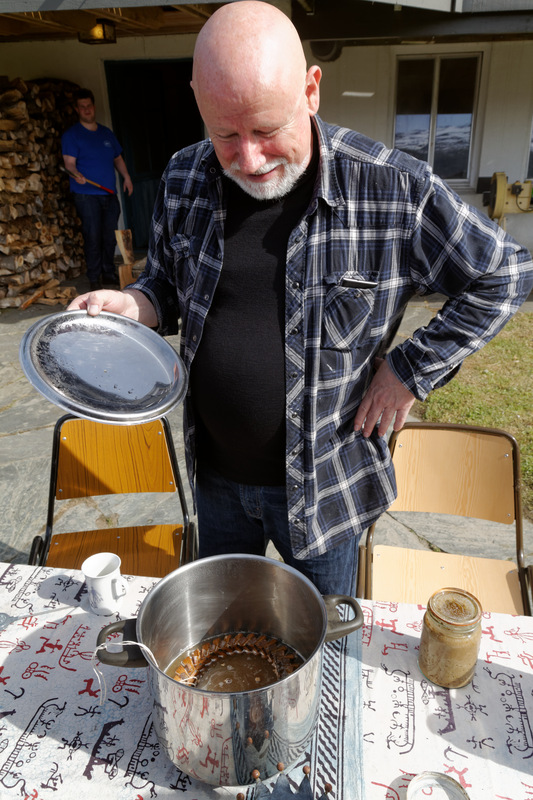
Sigmund with the starter |
By now Martin and I were getting very excited indeed. To see why, ask yourself how many really aromatic yeast types there really are. There's hefeweizen yeast, obviously. There's Brettanomyces. And there's ... there's ... there's actually not a whole lot else. So not only did Sigmund have his very own private yeast strain living in his fridge, but it was actually a yeast producing a totally unique aroma. Now we were beginning to see how Sigmund could brew with low-aroma hops, straightforward pilsner malts, and juniper, and still get an interesting beer. Yeast is often described as "the soul of beer," and rarely more so than for Sigmund's beer.
Sigmund, meanwhile, was taking no notice of the dazed beer writers walking in shocked circles on his lawn, and proceeded to boil the wort. And once we'd recovered enough to pay attention we were struck by another surprise. The boil, Sigmund told us, starts with the first runnings of the wort, then carries on for a few hours as all the wort is run off, and after that the entire wort is boiled for four hours. In fact, starting with 300 liters of wort Sigmund boils away half of it. Obviously, this, together with the wood fire and the copper kettle, is going to add both colour and flavour to the beer.
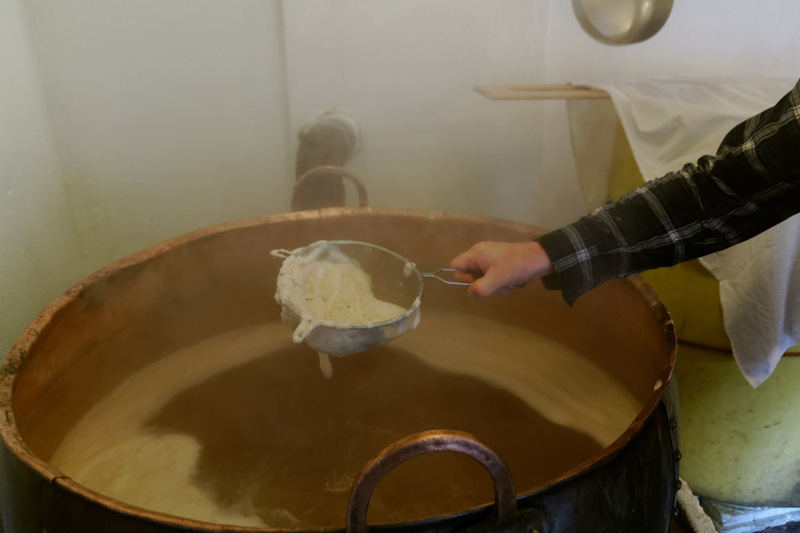
Removing "the headache" |
After a while, the "hot break" occurred, with protein coagulating out of the wort, and forming a thick porridge-like foam on top of the wort. Sigmund then picked out his sieve again, and scooped off the foam. "We call this 'the headache'," he told us. "You have to remove the headache." In addition to protein, he said, the headache contains quite a lot of juniper oil, so removing it reduces the rough juniper bitterness and some of the juniper flavour. "Now we're really making the beer," he said, showing how much emphasis the home brewers in Voss place on the boil.
Now we were getting close to the point where the kveik was going into action, so I brought out the little plastic bottles I'd taken on the trip in the hopes of getting kveik samples. Part of my plan was to get samples and send them to the National Collection of Yeast Cultures in Norwich, UK, for analysis so we could get a better understanding of what kveik really was. Sigmund took out metal measuring cup and spooned some kveik into it, stirring it to liquefy it. We then carefully poured two samples into two of the small plastic bottles, which I then tenderly wrapped up and stored in my suitcase.
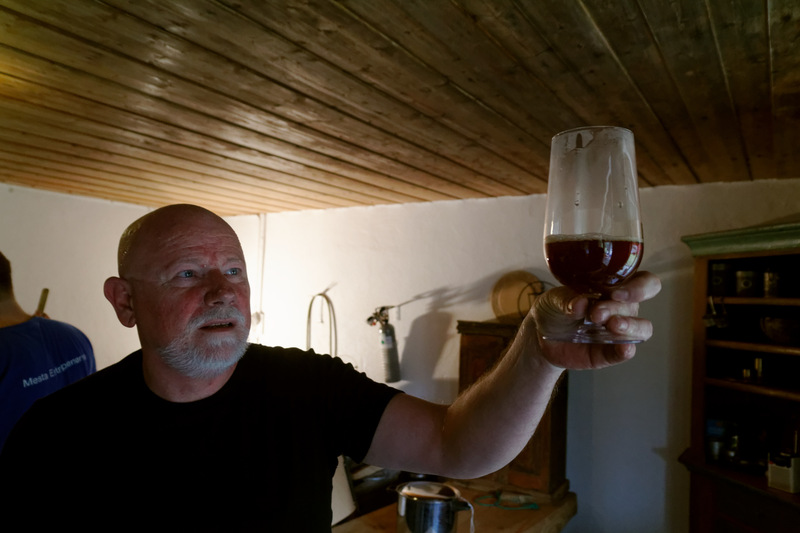
Checking the wort |
Once the wort had finished boiling it was noticeably darker, and as Sigmund had predicted, roughly half of it was gone. It was now transferred to the fermentation vessel, and a helical copper cooler used to cool it down for fermentation by running cold water through the copper pipe. The copper kettle was then scrubbed with steel wool, and I was surprised to find that none of the wort had burned into the bottom. There was a soft, dark, sooty layer on the bottom, but that was all.
The kveik was then added to the cooled wort, and Sigmund again insulated the vessel. When we asked him why, he said it was so the kveik would be warm enough. Puzzled by this we asked him how warm he fermented. "Up to about 39C," he says. Silence follows, as Martin and I stare at him. Other brewers consider the 29C the Belgians sometimes ferment at extreme, and here's someone going a good ten degrees warmer! Sigmund told us that his brother Gunleiv actually ferments even warmer, up to 43C, and gets more fruit character.
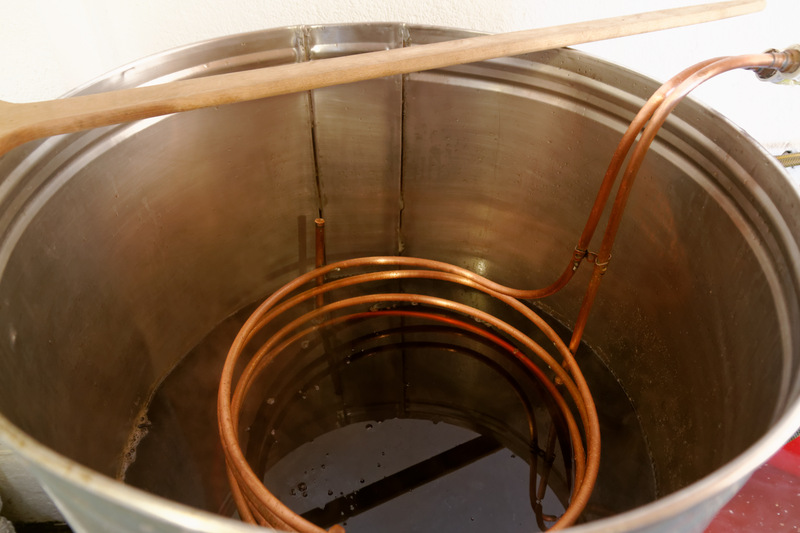
Home-made wort cooler |
Shaking our heads, we started packing our gear, because now the job was pretty much done. The kveik would work for 3-4 days before racking and transfer to the serving tank. Even before we left, a delicate orange-peel aroma was wafting through the cellar, a last greeting from our friend the mysterious kveik.
And with that, we thanked our hosts for letting us brew with them, and set off for Voss itself. Meanwhile, all sorts of questions were running through our minds. How on earth could a yeast like this remain unknown for so long? Were the other kveik strains in Voss anything like this one? Did kveik still live on elsewhere in Norway? If so, what aromas did those strains make? And what would be the final taste of the beer we just brewed?
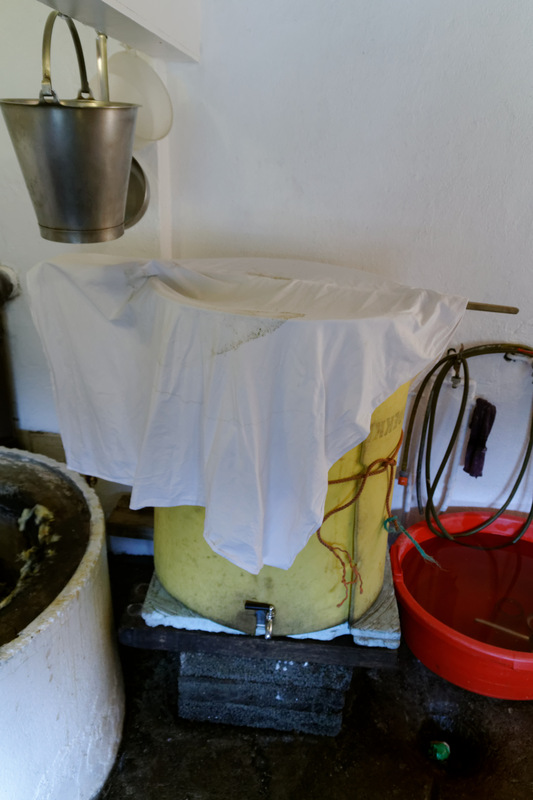
Shhh... here works the kveik |
(Martin's blog posts on the visit to Sigmund: part 1, and part 2.)
Recipe
Here's a quick recap of the recipe, with some additional detail. There are no measurements of OG, FG or IBU, because traditional brewers don't measure those.
- Use juniper infusion for everything, not water
- 50kg pilsner malts, to produce 300 liters of wort
- Mash for 6 hours (can be shortened to 3)
- Start mashing at 69C, don't go below 50C
- Add 250g noble hops, pressed flowers, to the mash
- Boil for 4 hours, preferably over a fire, reducing to 150 liters
- Add 200g Saaz hops 15 minutes before end of boiling
- Take care to use kveik for fermenting
Note that it is possible to order Voss kveik from NCYC. Sigmund's strain will be available from there later, once analysis of it is finished.
Similar posts
Brewing your own vossaøl
To better understand why vossaøl tastes the way it does I wanted to try to brew it with modern homebrewing equipment
Read | 2014-09-22 17:08
Eating burnt sheep's head
We'd booked a lunch at Smalahovetunet, for two reasons
Read | 2014-06-26 20:28
Voss - farmhouse ale central
We'd booked a camping cabin in Voss, but because of confusion over the booking, we were moved into a huge house with lots of rooms instead
Read | 2014-07-20 15:32
Comments
Dave P - 2014-06-22 09:45:15
Sounds like someone had a fabulous time?
The 'story' reminds me of Florida stills, making moonshine!!!
So... did you taste the output? Beer? remember? Images of Lars sneaking off with .5 grammes of 'kveik', laughing all the way home!!!
Thanks Lars, I'm jelous - would love to have joined you.
Lars Marius - 2014-06-22 10:09:32
@Dave: We did have a fabulous time, yes. We have tasted the output twice, and I'll be coming back to that. There's also the story of the analysis of the yeast, and a whole raft of other things.
But there are limits to what I can squeeze into a single blog post. Sorry. :)
Jon Gjerde - 2014-07-15 08:53:30
Great reading and pics:-) Sigmund always make great beer! with best KVEIK :-)
Levi - 2014-07-28 13:16:01
I just stumbled across this blog, and I am totally addicted (reading through back posts now)! As a homebrewer in the US with Norwegian ancestry this is right up my alley. I am looking forward to your yeast analysis post. Keep up the good work!
Lars Marius - 2014-07-29 05:47:43
@Levi: Thank you! Always nice to hear that people enjoy the posts.
Bryan - 2014-09-30 12:11:01
Lars, I hope you see this message
I am a homebrewer from Canada who maintains a large library of yeasts which I share extensively. I was hoping you'd be interested in trading yeasts with me. I use a simple mailer system which can make this quite cheap, and would be happy to send you multiple strains in return for you Kveik yeast (details of the yeast strains I have and how I mail yeasts can be found in the above link).
Let me know
Bryan
Lars Marius - 2014-09-30 13:29:07
@Bryan: I'll be in touch!
Rick - 2014-11-25 13:13:12
I was wondering if you could go into any more detail on the yeast ring. Seems like a cool idea, sort of a perpetual cool ship, would love to make and use one for my saisons. Near as I can figure its use must go something like
- rehydrate yeast placing ring in warm water
- add yeasty water and ring to starter
- add starter and ring to wort for primary
- remove ring and hang to dry
- drink beer
Does that seem about right? Essentially its topcropping right, giving krausen a place to settle?
Lars Marius - 2014-11-25 14:04:49
@Rick: The effect is very different from a lambic or saison if you use kveik, since those yeasts give a completely different aroma. The procedure you give would work. As I understand it, the normal procedure is to skip the water step. Also, as I understand it, the ring is just dipped in the krausen a few times to capture a good amount of it, and then hung up to dry.
Martin Warren - 2015-03-30 18:07:13
How extraordinary that in a country not renowned for being hot the yeast is happy fermenting at 39C. I can't imagine that it has evolved 'naturally' to ferment at such a temperature. After all, through the centuries, where in a Norwegian farmhouse has there been an environment that is kept at such a high temperature? Maybe 39C or 40C is not the yeast's preferred temperature but it just happens that it can tolerate it and so the brewer exploits this to stress the yeast and so it expresses more of the desirable fruity characteristics (i.e. esters).
How does Sigmund generate 39C in the fermenting vessel? Does he simply use insulation or does he keep the brew in a very warm environment too? Can he brew like this year-round? I think I would struggle to get 40C in my own house in England without artificial heat, so while insulation and the heat generated by furious fermentation must be an important factor I think I need a warm place, like an airing cupboard or a heated cabinet.
The time is drawing nigh when I will brew at Poppyland Brewery with the kveik that you placed in NCYC in Norwich. Exciting. Thanks for the post.
PS I must make a yeast ring or a yeast log.
Lars Marius - 2015-04-03 11:37:22
@Martin: 39C is the pitching temperature, so the temperature of the wort will continue to fall after that. However, Sigmund does insulate the fermentation vessel with a rubber foam mat. It's relatively cold in the basement, probably around 15C. You can see the fermenter here: http://www.garshol.priv.no/tmphoto/photo.jsp?id=t329710
I replicated the beer with a friend, and then we pitched at 35C and kept it in a bathroom with a temperature of about 25C. You can see the measured temperatures here: http://www.garshol.priv.no/blog/302.html I later brewed it again with another friend, and we pitched at 40C, but otherwise did exactly the same. The measured temperatures were very similar the second time.
Those pitch temperatures are much less unusual than they sound. In the Norwegian farmhouse ale survey (see http://www.garshol.priv.no/blog/300.html ) most of the respondents give the pitch temperature as "the temperature of freshly milked milk", and some specify 35-37C. The pitch temperature in Finland (before Finnish kveik died out) appears to have been the same. For Lithuania I find frustratingly varied numbers, so that needs more research.
Kevin Nielsen - 2015-12-22 13:36:59
This blog post is awesome! I love hearing about traditional brewing, and the kviek sounds amazing. I've been researching the wooden yeast rings because i want to make one and incorporate it into my own brewing, and my internet searches keep leading me back to this one post. Maybe someone here can tell me what type of wood the yeast ring should be made out of? Thanks Lars!
Lars Marius Garshol - 2015-12-22 16:32:25
@Kevin: Thank you, Kevin. The most common wood appears to be birch.
You can see more examples here: http://digitaltmuseum.no/search?query=gj%C3%A6rkrans
The Swedes also had these, as you can see here: http://digitaltmuseum.se/search?query=j%C3%A4string
They existed in Denmark, too, but I don't have any pictures.
Figuring out how to make the individual pieces is non-trivial, but I know Martin Warren http://poppylandbrewer.blogspot.co.uk/ was working on a design, with drawings and all. He also made a yeast log that he used successfully. So you could try contacting him, too.
KennyW - 2016-06-19 17:24:25
Just writing to say thank you to Lars and Sigmund for getting this Kveik into the hands of us homebrewers. I'm just finishing drinking off 5 gallons of ale I brewed using it. Absolutely incredible flavors and aroma. I can only liken the experience to a dream or something. The flavors and aroma transport me into some other parallel universe. I get that orange peel spice, ginger?, and slight tropical notes. I didn't have any juniper so I used some organic lavender flower tops and homegrown hops along with just 2 -row organic malt. I left it uncarbonated but naturally you can say it is petulant. I'm going to try and keep the yeast going for generations. There really is nothing like it I've ever experienced. I've found an ale I can drink until the day I die. Thank you.
john - 2017-01-08 13:10:22
Vincey was in Voss Norway unforunately they didnt take kids to see the brewing process
James Tinker - 2017-01-29 13:07:38
Truly brilliant article. Many thanks
James Tinker - 2017-01-31 14:32:45
One more thing. There seems to be no mention of sparging or at least I may have missed it. It seems the first run off is added to the copper cauldron. Did he sparge?
Lars Marius Garshol - 2017-01-31 15:17:20
@James: Thank you. Yes, he did sparge, by adding cold water at the end of the running to get the last sugar out.
Joel - 2017-07-17 09:32:09
So happy to have stumbled upon this! Living in Laos (tropical and hot), this may be a fantastic option for brewing farmhouse style ales. Now the problem is how to get some of the yeast! Does anyone know of any options for purchasing a pre-made "yeast stick", or a dried version? I've seen the isolated yeast (​SIGMUND'S VOSS KVEIK), but shipping liquid yeast doesn't seem to be an option. But, dried and stable just might work. Any ideas? Many thanks!
Russell Cook - 2017-09-23 00:18:11
Hi Lars,
I'm a fan of your blog, and would like to try and create my own "yeast stick" modelled on the same principle as the ring.
Since I live in a subtropical climate (Brisbane, Australia), how would you recommend keeping it over the hot summer months? My idea was to dry it and then keep it in an airtight container.
Also, the yeast strain I would try to collect on the stick would be a commercial English or American ale yeast.
Any ideas on how to give it a chance of success would be great.
Lars Marius - 2017-09-23 10:00:14
@Russell: To be honest I'm not sure how it would work in that kind of heat. The humidity and what kind of bugs float in the air would also matter. So the outcome is kind of unpredictable.
The trouble with collecting commercial yeast is that most of these don't tolerate drying, so drying is likely to kill them. The exception is if you use a dry yeast. Kveik can handle drying, so the best would be to find one of those.
Jeff Scanlan - 2018-03-02 18:16:01
Sorry for the long bump, but it feels like this is all brand new, at least to the brewing community here.
I just purchased the Wollsaeter yeast from Mainaical yeast. I am hoping to brew my very first raw ale, following your procedures/or home-brew version of procedures.
We have access to Juniper, but certainly not that species and I am concerned getting too much juniper in the brew. It is a very strong flavor and I am sure easily overdone.
Have you come up with any guidelines for appropriate weight of juniper for use in a mash tun, say for 20 liters or a gram/liter ratio for juniper infused sparge water?
thank you
Brian Thompson - 2018-08-12 03:20:43
Sounds amazing and really fun to try. Any idea what type of juniper was used and approximately how much? I have juniper around me (Juniperus monosperma (one-seed juniper) but have no idea if this will create a similar beer.
Ja i ja - 2019-03-21 08:03:35
Fantastic story, thank you! My next beer: Voss Kveik + Mandarina Bavaria...
Corey J Adams - 2019-04-03 00:50:00
Great read! We just brewed our first beer with the Voss Kveik strain, would you mind if we used your Yeast Ring image as part of the label?
Vita Kopil - 2019-08-19 06:35:40
Good afternoon I collect a collection of attributes of famous beer brands, well known by all! I dream to open a drinking bar, send me beer glass, bermets, birdekel, labels, souvenirs to advertise your beer, thank you! I love your beer, super beer! happy !
My address: Viktor Kopyl Chornovola 120 f.5 Cherkasy , Ukraine 18003
Phillip Taud - 2020-09-26 11:00:23
Hey there,
thanks for all your great insight into yeast and especially Kveik. I have a question regarding the colour of the final beer. You see a lot of results with the voss kveik ending either with a mango juice colour or ending in a very clear colour. Do you have any idea what affects that, assuming no filtering or filtering agent is used?
Brulosophy brewed a great example of clear Voss Kveik beer: http://brulosophy.com/2019/04/08/fermentation-temperature-imperial-yeast-a43-loki-kviek-exbeeriment-results/
Others end up like this: http://goodbeer.blogspot.com/2018/02/kveik-blonde-ales.html
I am currently cold crashing my first brew with voss and am interested to find out to colour soon. During fermentation it looked rather like mango.
Regards Phillip from Germany
Patrick Wiens - 2022-04-11 19:35:50
Hi, I'm a homebrewer in a small city in the brazilian South called Irati... Today is monday, april 11h of 2022, and last saturday I brewed 36 liters of an APA... the yeast mud I was saving for it smelled a little sour. So I had no doubts, I had a pack of mangrove's Voss yeast in the fridge, so I just poured it over. An hour later the airlock was pumping already. Thank you, Sigmund Gjernes!
Jeremy - 2024-03-13 15:00:20
Pitched two 1 gallon batches of mead with Omega kveik Sundew yeast. 1 is a pog(passion fruit, orange, and guava) with lehua honey 12%abv. The other is just lehua honey mead 13% abv. This weekend I'll be pitching with either Voss or Kveiking for a pog 2.0. Both batches smell so fruity. It was a slow start for me. I have so many questions about kveik as these are my first batches with kveik.